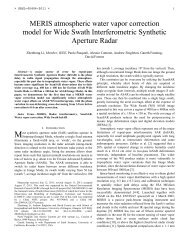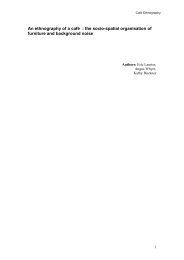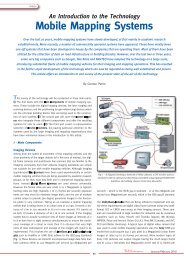Houdini and the wonder of
Houdini and the wonder of
Houdini and the wonder of
You also want an ePaper? Increase the reach of your titles
YUMPU automatically turns print PDFs into web optimized ePapers that Google loves.
as our friends <strong>and</strong> colleagues, ‘he appeared just to be ano<strong>the</strong>r guy walking along <strong>the</strong><br />
street’. Until we discover <strong>the</strong> absence <strong>of</strong> our wallet he was just ano<strong>the</strong>r guy walking<br />
along <strong>the</strong> street.<br />
There is a familiar worry about whe<strong>the</strong>r <strong>wonder</strong> is a function <strong>of</strong> ignorance, so<br />
that <strong>the</strong> more knowledge we acquire <strong>the</strong> less room <strong>the</strong>re is for <strong>wonder</strong>. But on<br />
my account, <strong>wonder</strong> is not under threat from knowledge, it is under threat from<br />
a certain way <strong>of</strong> looking at things [Anschauungswiese], a pun deaf way <strong>of</strong><br />
looking at things. The enemy here is <strong>the</strong> voice <strong>of</strong> common sense, <strong>the</strong> defender<br />
<strong>of</strong> <strong>the</strong> obvious [Selbstverständlichkeit]. The enemy <strong>of</strong> <strong>wonder</strong> is a certain<br />
attitude to our epistemic practices, <strong>and</strong> <strong>wonder</strong> is made possible by a change in<br />
our attitude to those practices ra<strong>the</strong>r than by any failure <strong>of</strong> those epistemic<br />
practices on <strong>the</strong>ir own terms. (Bearn 1997 p196)<br />
<strong>Houdini</strong> allows <strong>the</strong> possibility that we can be fooled, <strong>and</strong> that under certain<br />
circumstances we want to be fooled, though not by <strong>the</strong> state, not by <strong>the</strong> thief, not by<br />
our building society, not by our newspaper 10 . We want to be fooled when we are<br />
ready to be fooled, when we are expecting to be fooled <strong>and</strong> when everyone <strong>of</strong> us will<br />
be fooled at <strong>the</strong> same time 11 . Seeing <strong>the</strong> trick, like getting a dirty joke (Sacks 1978), is<br />
a non-trivial exercise since let us imagine for a moment a person lacking <strong>the</strong> capacity<br />
to see that <strong>the</strong>y have been fooled (before we even consider underst<strong>and</strong>ing how you<br />
have been fooled). For instance we cannot do card tricks to amuse our cat, nor amaze<br />
it by escaping out <strong>of</strong> a locked trunk. Seeing a trick is already <strong>the</strong>n a shared human<br />
accomplishment 12 .<br />
Where a member <strong>of</strong> an audience joins with ethnomethodology’s ethos is in awakening<br />
in <strong>the</strong>m a sharpened curiosity to know how <strong>the</strong> magician does what he does. At one <strong>of</strong><br />
<strong>Houdini</strong>’s or Blaine’s shows <strong>the</strong> audience might fully examine <strong>the</strong>ir own sensemaking<br />
procedures to consider how <strong>the</strong>y have be fooled, more likely <strong>the</strong>y will accept<br />
<strong>the</strong> possibility <strong>and</strong> enjoy <strong>the</strong> show without needing to get to <strong>the</strong> bottom <strong>of</strong> <strong>the</strong> trick’s<br />
lived work. We should be careful here as to how far we wish to equate<br />
ethnomethodology’s awe at ‘commonplace action’ (p87 Blum <strong>and</strong> McHugh) with <strong>the</strong><br />
tricks <strong>of</strong> magicians. It is <strong>the</strong> ethnomethodologist who has a similar sense <strong>of</strong> awe at<br />
commonplace actions as an audience has for <strong>Houdini</strong> or Blaine’s spectacular feats.<br />
And it is <strong>the</strong> ethnomethodologist who departs from <strong>the</strong> logic <strong>of</strong> an audience when<br />
<strong>the</strong>y pursue <strong>the</strong> clarification <strong>of</strong> <strong>the</strong> particular devices which produced <strong>the</strong> magic. If,<br />
<strong>and</strong> when, ethnomethodologists pursue <strong>the</strong> misdirections <strong>of</strong> magicians or equally <strong>of</strong><br />
‘sincere liars’ (Lynch 1996), while <strong>the</strong>y are awed by <strong>the</strong>m <strong>the</strong>y might no longer be<br />
affirming convention.<br />
Moving away, from doing being an audience, to doing a magical trick we will run up<br />
against <strong>the</strong> training required <strong>and</strong> <strong>the</strong> effort involved to present what <strong>the</strong> audience<br />
should see <strong>and</strong> hide what <strong>the</strong>y should not. There are times, where even with <strong>the</strong> best<br />
instructions, as a trainee magician still cannot grasp how a certain trick works. Is this<br />
10 There are exceptional occasions when we will allow this – April 1 st being <strong>the</strong> most obvious example.<br />
11 As also in G<strong>of</strong>fman’s (1974) later attempt to reformulate what he had come to see as a fundamental<br />
problem with his dramaturgical reductions in ‘The Presentation <strong>of</strong> Self in Everyday Life’. He realised<br />
that acting on stage involves special permissions from both actors <strong>and</strong> audience <strong>and</strong> is made sense <strong>of</strong><br />
by its sense as <strong>the</strong>atre not as part <strong>of</strong> <strong>the</strong> flow <strong>of</strong> a pavement or talk around a family breakfast table.<br />
12 There are parallels here to Sack’s (1992 vol.2) consideration <strong>of</strong> <strong>the</strong> dirty joke as a technical object.<br />
12
















